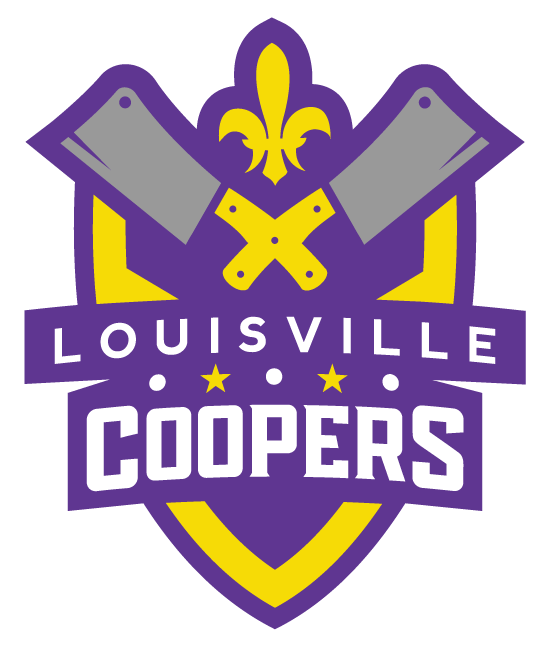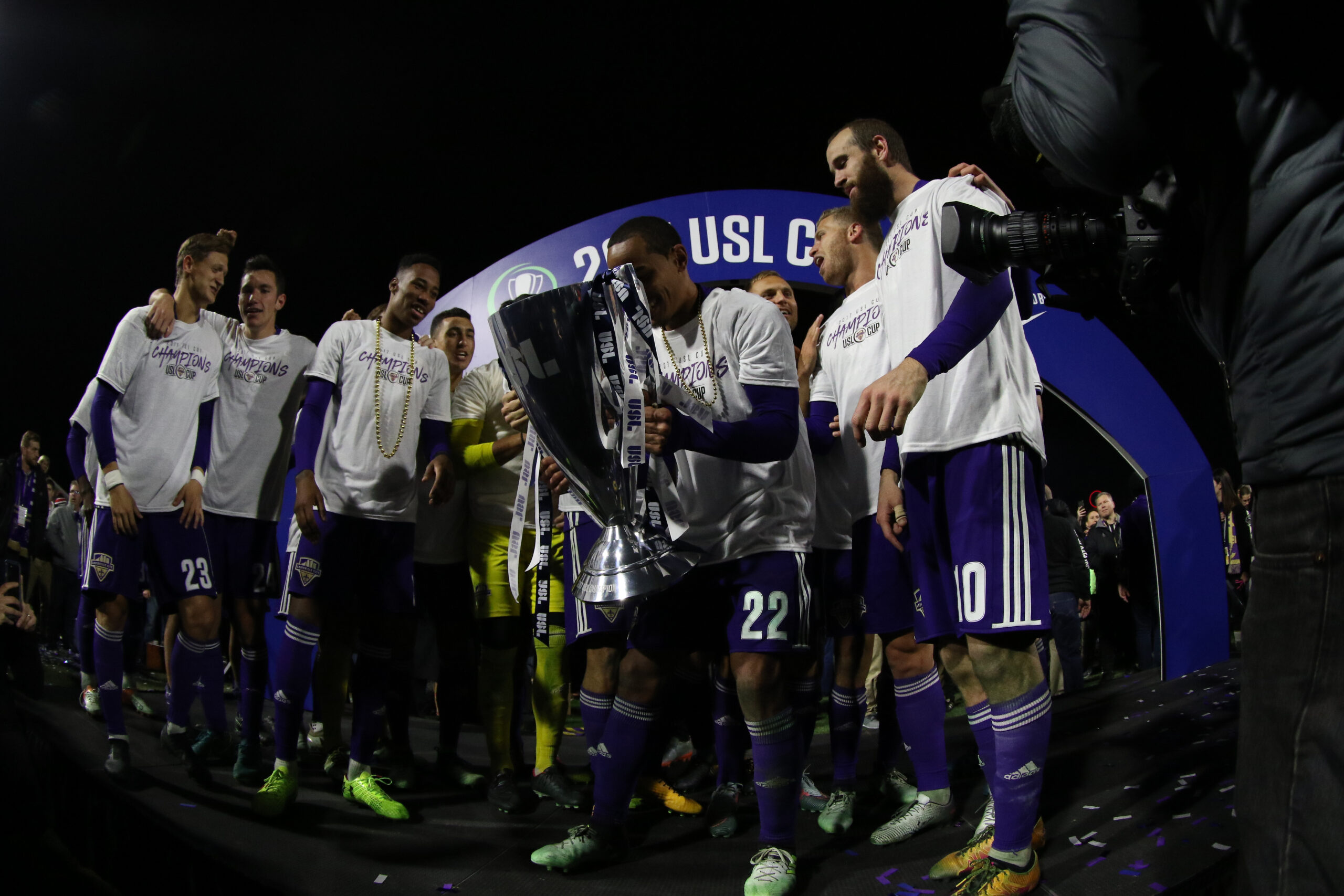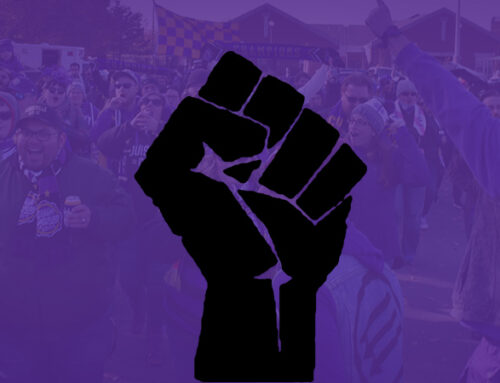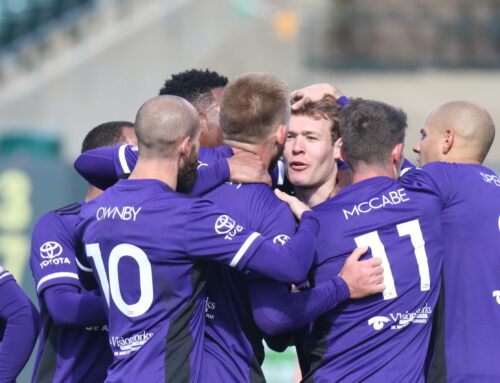[Ed. Note: Andrew Oost is back!]
This is the first of a three-part series which will serve as a “State of the Union” equivalent for Louisville City FC, from a supporter’s perspective. I make no claim to speak for anyone other than myself, nor do I have any insider knowledge. But as a keen observer of the club since before the first ball was kicked, I’m hopeful that these ramblings may strike an agreeable cord with more than a few readers.
The first part of the series attempts to focus on the past, present and future state of the team itself.
It would be hard to write a script better than the one fate has handed Louisville City Football Club since its inception in 2014. The club has had more on-field success than any other professional side in American soccer in that span, including consecutive USL Cup Championships in the past two seasons. City has been just as impressive off the field, with a passionate and engaged fanbase that seemingly manifested out of thin air, and a jewel of a stadium under construction and scheduled for a 2020 opening.
The Obligatory Gripe
Before we delve too deeply into all that is good and right in the world of LCFC, allow me a slight digression into well-trod territory regarding our club and it’s place in the United States soccer hierarchy.
Shortly after the USL Cup, the point was made that Louisville City may be the first team in history to ever repeat as champions of a second division in the history of soccer. Literally, the first team ever. Although an amusing anecdote, it’s a true statement due to the obvious lack of promotion and relegation in US Soccer. I suspect that it will become less and less funny should Louisville City win a third, fourth, or fifth USL title in a row.
Long before news of Cameron Lancaster’s departure, it had already become apparent that for a certain class of player, Louisville City represents a stepping stone. A very nice, well-run, well-supported stepping stone, but a stepping stone nonetheless. No matter how excellent the organization, coaching staff, fans, stadium, or quality of life may be, the cold, hard reality of economics seems destined to come in to play, year after year. Players will continue to leave Louisville City in order to earn more money, to have the opportunity to compete in a higher division, or both. And both reasons are completely valid.
We can now add Lancaster’s name to the list of great players (and coaches) who’ve reluctantly had to leave the club to escape the state of “permanent relegation” that Louisville City exists within. Cameron is not the first (see: Fondy, Burke, Kaye, O’Connor), nor will he be the last (looking squarely at Craig, Ranjitsingh, and Williams). It’s not the fault of the players, or of the club. It’s the fault of the system, and it’s one that currently appears entrenched and unmovable.
Lower division, small-budget teams the world-over have always had their talent poached by bigger clubs. However, the situation that lower division clubs in the United States face, particularly Louisville City, is that without the opportunity to win promotion to the first division (which rightfully could have occurred in every season of LCFC’s existence), their best players are essentially forced to leave if they want to participate at the highest level.
It seems as if lower division soccer is nothing more than a ragtag underclass of soccer serfs, merely existing as a defacto farm system from which MLS clubs are free to plunder with impunity, both players or even entire organizations (see FCC, Orlando, Minnesota, etc.). Are you an aspiring club, but one that may lack the requisite money or metrics to ‘earn’ a spot in MLS? No problem, but you’ll still have to pay your tribute in the form of your best players and coaches.
Louisville City only raises an eyebrow in this high-society only insomuch as they are seen as the most precocious and noisy member of that lower caste, and have gained a reputation as a fertile hunting ground for talent. When the USSF/MLS bosses look at Louisville City, if they bother to look at all, they might see a successful and well-run club, thriving in a growing second division, thanks to their benevolent stewardship. The reality is that Louisville City, and many other well-run, well-supported lower division clubs, have succeeded in spite of USSF/MLS, rather than because of them.
One could argue such pessimism in unwarranted in the midst of such golden days for the club. Indeed, the future is bright for Louisville City FC, regardless of their position of the broader landscape. However, having been a longtime observer of the wretched mismanagement of soccer in this country, I would caution that we will sooner see a fist from USSF/MLS punching downwards towards us, rather than a helping hand offering to pull us up.
With all that in mind, the question becomes: Where do we go from here?
The Winning Tradition
Thanks in large part to James O’Connor, Louisville City established a winning culture and positive mentality from the very beginning of the club. The team started out winning, and never stopped, even after O’Connor’s departure. It’s an interesting thought experiment to consider how things would have turned out had the team not been so successful on the pitch.
Imagine if the club had missed the playoffs in the first couple of seasons. Imagine if the team had suffered massive roster-turnover every year due to lack of chemistry and camaraderie. Imagine if the crowds had dwindled, and the supporters enthusiasm had waned due to the weariness of constant defeat. Imagine if the stadium project never gained momentum, and existed for fans only as pretty renderings to be dreamt about, but with little hope of ever walking inside.
This didn’t happen, though. The stars aligned, and through some mysterious alchemy of hard work, good luck, fortunate timing, charismatic leadership, and delightful support, Louisville City emerged in the sweet spot and has never looked back.
There is absolutely nothing indicating that Louisville City will do anything other than continue to win in the near future. For the second straight season, City has inked 15+ players from a championship roster for the follow up season, an indication of player loyalty almost unheard of at this level of soccer in the US.
It would have been understandable if John Hackworth had wanted to stock the roster with a collection of hand picked players for his first full season in charge. It would have been easy to envision him keeping a half dozen core players, perhaps just the returning starters, and letting the rest of the team go. Instead, Hackworth appears to have invited back every player from the 2018 roster. He understood that the chemistry and winning culture within the locker room was more valuable than any cadre of new blood that he might be able to lure in.
That’s not to say that there won’t be fresh faces on the 2019 roster. It’s reasonable to expect 5-6 additional signings over the off-season, assuming that Hackworth prefers to operate closer to a traditional 23-man roster, rather than the lean-and-mean small rosters that O’Connor preferred. It’s also reasonable to expect that Hackworth’s experience and network of connections, coupled with LCFCs aforementioned track record of success, will be more than enough to entice plenty of high quality players into the fold for 2019.
Allow me one statistic to convey the dominance of Louisville City in its young existence. Louisville City’s goal differential across all competitions (USL, Playoffs, and Open Cup) in four seasons is a staggering +138. That is really, really good, folks.
Keeping that number in mind, and realizing that LC are two-time defending champions, have never finished lower than second place in the entire league, and will be returning 75% of their roster, it’s fair to expect continued excellence. And just to be clear, by “continued success”, I am referring to winning the USL Cup again. Anyone who thinks LCFC is anything less than the clear favorite to repeat as champions is deluding themselves.
A New Priority: Winning the US Open Cup
Louisville City should throw everything they’ve got into winning the US Open Cup in the next few years. The USOC represents the only chance to take a swing at MLS head to head, and there is no reason to believe that LC can’t claim a prominent scalp or two each and every year.
Maintaining consistent league form in the midst of USOC run is fraught with difficulty, and concessions from one competition are needed in order for the other to be successful. The anticipated larger roster size for 2019 should help to ease the burden of managing simultaneous competitions. Now that Louisville City has two USL Cups in their pocket, it may be the appropriate time to shift some eggs from the USL regular season basket into the US Open Cup basket.
Since the inception of MLS in 1996, only one non-MLS team (the 1997 Rochester Rhinos) has won the USOC. It’s high time someone else made another serious run at The Cup. There is simply no better candidate than Louisville City in the lower divisions of American soccer.
This past season, LCFC advanced further than any non-MLS team in the competition. Yes, they were thoroughly dismantled by a dubious Chicago Fire squad in the quarterfinals, but Louisville City was without a proper coach at the time, and frankly it showed during that game. It’s hard not to think that had LouCity been on the form they were during the last six weeks of the season, once Hackworth settled in, that they wouldn’t have made a serious run at the Open Cup.
So while it may seem like a bit of a pipe dream, the USOC may not be as unattainable as it may seem at first glance. MLS teams generally don’t start putting out their top teams in the competition until around the quarterfinals. At that point, only two games remain before the final. If LC were to structure their season and place a value on the Open Cup greater than the MLS clubs, the chance of grabbing the Cup becomes very real.
For those unfamiliar with what winning the Open Cup would entail, allow a brief summation. Louisville City would be automatically entered in to the CONCACAF Champions League, which is a federation-wide tournament consisting of teams from North America, Central America, and the Caribbean. In the season following an Open Cup triumph, City fans could find themselves making travel plans to Mexico City, Costa Rica, or Trinidad. A lower division team gaining entry into a continental wide club tournament is almost unheard of in soccer, but it has happened on rare occasions, and would certainly be a monumental statement by Louisville City.
On a perhaps even more important note, the only time Louisville City and FC Cincinnati will face each other in coming seasons is in the Open Cup. In fact, with the regional matchups that USSF tends to promote in the competition, it is a near certainty that the Dirty River Derby will live on via the USOC.
The Academy
It’s clear that a major factor in the hiring of John Hackworth was his experience in youth soccer development. He served as Head Coach of the U-17 Men’s National Team on two separate occasions, for several years in each stint. He has worked with hundreds of talented youth players, many of whom have gone on to successful professional careers, some even becoming outright stars.
All indications point towards Hackworth being tasked with developing an academy setup at Louisville City FC. In interviews, Hackworth has exuded enthusiasm at the possibility of starting an academy from scratch, and it’s not hard to see why. If building an academy was indeed a goal that LouCity management had in mind during the coaching search, the hiring of John Hackworth to do the job represents a major coup.
A well-run, well-funded academy would cement LCFC as the nexus around which all soccer aspirations in the region gravitate towards. The academy should be free, or at least heavily subsidized by the club. The “pay-to-play” model has stifled the development of soccer in the US for far too long, especially within immigrant, working class, and minority communities. Countless talented young players have been overlooked or driven from the game due to lack of resources.
Thankfully the system is starting to change, and high-quality academy systems have been emerging in the US over the past several years. FC Dallas, New York Red Bull, LA Galaxy, and Real Salt Lake, among others, have all established excellent programs that have produced scores of players that have gone on to represent the the first team, the national team, or been transferred to European clubs for hefty fees. There is no reason to think that Louisville City can’t replicate or even exceed what many of the successful MLS teams have done in this arena.
Another reason to start a competitive Louisville City academy as soon as possible is that fact that FC Cincinnati announced in October that they are starting their own, and we can be certain than Nashville SC won’t be far behind. Although FCC (and soon NSC) are no longer in USL, geographic proximity necessitates that LCFC will be competing with those clubs for regional talent, probably forever.
In conversations I’ve had with local “soccer people” in regards to a Louisville City academy, there has been plenty of concern about potential conflicts with established local youth soccer clubs. While Louisville City should make every effort to be respectful of the history and tradition of the established clubs, and to be mindful of the various stakeholders whose livelihoods are rooted in these clubs, there is no need to be overly deferential.
Quite simply, if the LouCity Academy is able to provide a higher quality, more affordable, and more attractive option to young players than the established youth clubs and/or high schools are able to, players and their families are most likely going to choose the academy. That is not something for which Louisville City should have to apologize.
Things change and evolve, and Louisville City is now the biggest show in town. The goal should be for every local player with higher aspirations in the sport to be vying for a spot in the academy. There is bound to be some pushback from a few with a stake in the current structure, but it shouldn’t be all doom and gloom for the people managing the existing youth clubs. The LC Academy will have a need for quality coaches and administrators who understand the local soccer scene, of which there are many. With the recent hiring of former UofL Men’s Assistant Mario Sanchez to head up youth development, it appears the club is keen to integrate people with local connections.
An academy is a long term investment. The majority of the players who participate will not go on to immediately step into the Louisville City first team, get drafted into MLS, or be signed by a club abroad for a hefty fee. However, securing a college soccer scholarship should be an attainable goal for most academy graduates, especially considering the soccer education they would receive is likely to be as good or better than anything that has heretofore been available in the region.
An academy is also about establishing a culture. Regardless of how their soccer careers pan out, graduates and their families will become lifelong ambassadors for the club. Much in the same way college alumni become fans and supporters of their school for life, so will the academy kids. Building a positive culture always starts with the youth.
The Local Connection
Whether an academy exists at Louisville City, or not, many talented youngsters are still going to opt for the college soccer option. While skepticism is warranted as to the value of college soccer for a player with serious professional aspirations, the idea of college athletics is still imbedded in United States, and is still a priority for a majority of young athletes.
Fortunately, Louisville City is surrounded by numerous top-shelf college soccer programs. This past season, Indiana, Kentucky, and Louisville were among the top four seeds in the College Cup. In 2018, Louisville City’s roster included players from the Kentucky (George Davis IV, Napo Matsoso), Louisville (Paolo DelPiccolo), Indiana (Richard Ballard), Transylvania (Kyle Smith), and Lindsey Wilson (Shawn Francis). Matsoso, Ballard, and Chris Hubbard attended high school in Louisville as well. That represents a significant portion of the roster with local high school and/or collegiate ties, and I think that’s only scratching the surface of available talent available within a two hour drive.
If a soccer player graduates from a local university without securing an MLS or overseas deal, Louisville City FC should absolutely be the first club they are looking towards. John Hackworth knows the youth development and college system as well as nearly anybody, and it would be surprising if he didn’t use his contacts and experience to cast a net both near and far for talent. It’s reasonable to expect that the university pipeline will only continue to grow in the near future.
In Hackworth We Trust?
I can’t recall exactly when or who coined the phrase “In O’Connor We Trust”, but it was probably sometime in the off season between the second and third season. JOC had proven time and time again that he could discover players from the most obscure backgrounds, plug them into his system, and turn them into worldbeaters. If nothing else, it meant that the players, the ownership, and the fans had complete faith in JOC. It wasn’t blind faith either, it was a hard earned faith based on constant success.
While it’s not quite time to bestow such faith in Mr. Hackworth just yet, his performance over the past five months has been remarkable. He inherited a team that could well have been in disarray, but had somehow managed to steady itself in the nearly six weeks since O’Connor had departed. While there a few unlucky and disappointing results in the first month of his tenure, Hackworth eventually got the train rolling at full steam.
Starting with a 0-3 victory at Penn FC on September 19, Louisville City would go on to win the final six games of the regular season, and then sweep through the playoffs to secure their second consecutive crown. During that 10 game winning streak, the team outscored its opponents 29-5.
Hackworth has been the first to credit the players for the achievement, and indeed they deserve the lion’s share, but he deserves a healthy dose of respect as well. He settled into a consistent starting lineup and formation, slightly modified some tactics, and the results bore out the success of his approach. By the time the USL Cup Final against Phoenix came along, the team was such a well-oiled machine that the victory seemed to come with relative ease.
Hackworth has been engaging off the field as well, opening up to the media and fans, displaying a bit more personality than the somewhat tight-lipped and evasive O’Connor. He’s tentatively dipped his toes into social media, appeared on fan podcasts, downed pints with supporters, and generally been everything one could hope for from a manager of a club of this stature.
So while it may be slightly premature to proclaim “In Hackworth We Trust”, the time to start believing may be coming soon.
In Part Two of “Where Do We Go From Here?”, we’ll be looking at the club/organization of Louisville City FC, dishing out plenty of compliments, a few critiques, and lots of ideas and speculation on what the future might hold.













